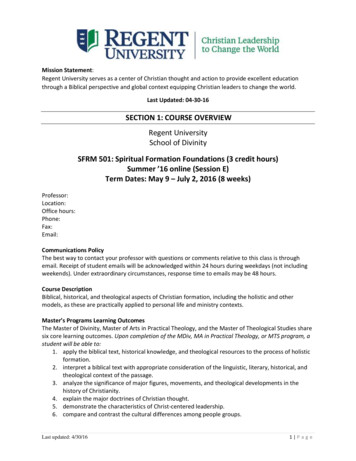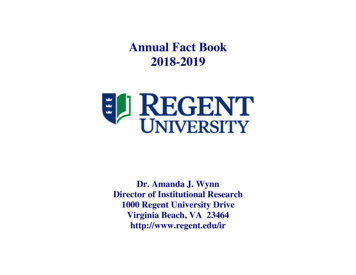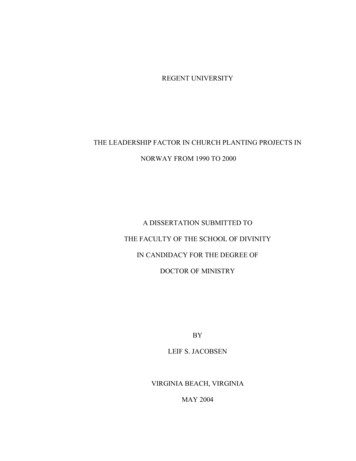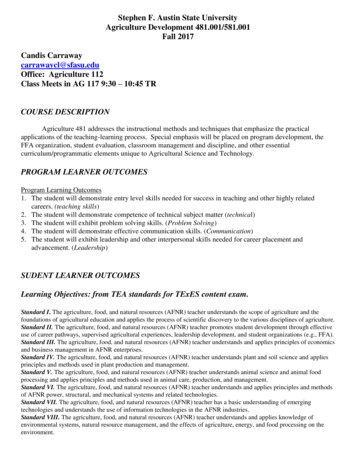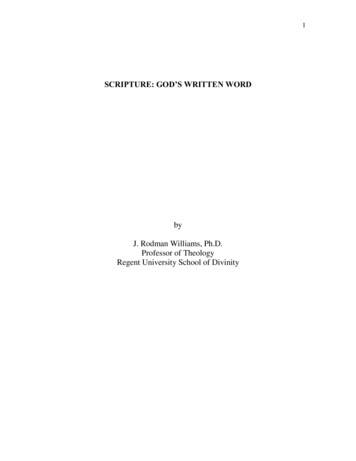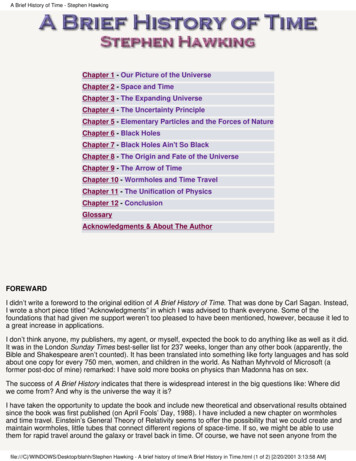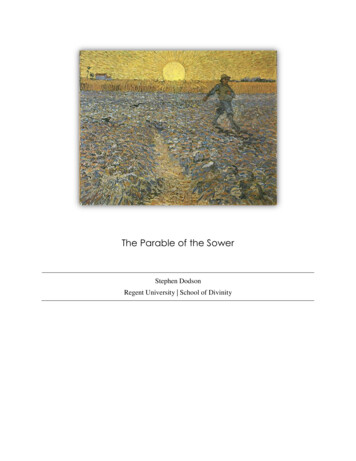
Transcription
The Parable of the SowerStephen DodsonRegent University School of Divinity
2IntroductionIn Matthew 13:3-9 Jesus shares the Parable of the Sower with a large crowd thathad gathered. This parable could more descriptively be called “The Parable of the Soils” sincethe figure of the sower is seen only in the introductory verse (Mt 13:3).1 Following the parable,the disciples ask Jesus for an explanation. Jesus then shares a discussion of the mysteries of thekingdom which is found in Mt 13:10-17. Following this He shares with His disciples anexplanation of this parable. Matthew records Jesus’ explanation in Mt 13:18-23. The parable ofthe sower is also recorded in Mk 4:3-20, and Lk 8:4-15.An expository interpretation of the parable will first examine the context which showsthat Matthew positions this parable at a transition or pivot point between Jesus’ ministryexperiences in Matthew 11-12 and the kingdom parables in Matthew 13. Second, aninterpretation needs to focus on the six elements of the parable including the condition of eachsoil, and then take into consideration Jesus’ own explanation of the parable. And third, anapplication of the parable will lead the reader to examine the condition and receptivity of theirown lives to become a true hearer of the Word.Jesus’ contrast between the three unproductive soils and the one productive soil serves asthe dominant literary relationship in the parable and leads to the central point which is thereception of the seed into the soil.ContextIn The Parables of the Kingdom C. H. Dodd say that “To understand the parablescorrectly one must seek to interpret them in their original Sitz im Leben, or setting in life.” Healso pointed out that "Before one seeks to understand the relevance of the parable for the believertoday, one must seek to understand the original meaning that Jesus intended for his listeners inthe first century" 2Larger ContextThe book of Matthew can be divided into five books. Matthew positions the parable ofthe sower in Book III “The Christ of the Church” (Mt 11:2-13:53). Hull describes the narrativefrom Mt 11:2 – 12:50 as “Reactions to Christ”3. As Jesus goes out to teach and preach in thecities (Mt 11:1), the responses of the people are recorded. These responses support the idea that1. J. Lyle Story, The Parable of the Soils: Matt. 13:3-23 (Regent University: School of Divinity),1.2. Robert H. Stein, The Methods and Message of Jesus’ Teachings, rev. (Louisville: WestministerJohn Knox Press), 52.3. William E. Hull, "Teaching outline of the Gospel of Matthew." Review & Expositor 59, no. 4(1962), 433-444, ATLA Religion Database with ATLASerials, EBSCOhost (accessed November 6, 2011).Stephen Dodson Fall 2011
3this parable is a pivot which serves as a summary of Jesus’ experiences in Chapters 11-12 as wellas an introduction to the Matthew 13 kingdom parables.In this “reactions to Christ” narrative Matthew develops a broad literary contrast betweenthose who received Jesus and His message, and those who rejected Him. In Mt 11:20-24 Jesusdenounces the cities in which He has performed miracles because they did not repent. Thecontrast is seen in Mt 12:1-8 where the disciples are with Jesus, following Him and learning, yetthe Pharisees reject Him for unlawful acts on the Sabbath. In Mt 12:9-13 the religious leaderswho reject Jesus are contrasted with the man with the withered hand who receives healing. In Mt12:14-15 the Pharisees “Conspired against Him, as to how they might destroy Him” (Mt 12:14),yet “Many followed Him, and He healed them all” (Mt 11:15). Mt 12:22-23 gives anothercontrast of those who receive from Jesus and those who do not. In verses Mt 12:24-30, thePharisees again reject Jesus as they accuse Him of using the power of Beelzebub to performmiracles. Also in Mt 12:38-41, Jesus condemns the scribes and Pharisees because they ask for asign instead of receiving the kingdom through Jesus ministry.With this contrast Matthew portrays Jesus as a sower of the seeds of the kingdom. Theseencounters of receiving and rejecting Jesus’ message is analogous to seed being scattered onvarious types of soil. Many rejected the seed, but a few received His message.Immediate ContextMt 13:1-2 serves as an introduction for the parable and provides an immediate context.“That day Jesus went out of the house and was sitting by the sea. And a large crowd gathered toHim, so He got in a boat and sat down, and the whole crowd was standing on the beach” (Mt13:1-2) (NASB). From this position in the boat, Jesus begins to share parables with thosegathered there that day.It is likely that Jesus may have been recounting His experiences of ministering in Mt 1112. Then, as in the parable, He repeatedly sowed the message of the kingdom to various peopleand conditions of receptivity. C. H. Dodd suggests that Jesus may have been “Thinking aloudabout the fortunes of His work in Galilee, with its mixture of failure and success.”4Life SettingIn the agrarian culture of first century Palestine, Jesus’ audience would have immediatelyrecalled the image of a farmer sowing and scattering seed by hand as he walked through his field.Wenham states that these peasant farmers would have been very aware of the importance ofhaving a productive crop upon which their livelihood depended. He goes on to say that only thevery rich among them would have been unaffected by an unproductive harvest.5 Jesus’ intention4. C. H. Dodd, The Parables of the Kingdom (New York: Charles Scribner’s Sons, 1961), 145-6.5. David Wenham, The Parables of Jesus (Downers Grove: Inter Varsity Press, 1989), 42.Stephen Dodson Fall 2011
4in using a farming illustration was simply to connect with His audience. His true purpose was toteach a lesson about bearing spiritual fruit.6Lightfoot describes the conditions of the farming conditions for these farmers. Thesefields were often small plots of land separated by well-worn paths for accessibility. When theseed invariably fell upon these paths, it would have little chance for growth. The rocky groundwas a shallow layer of soil on top of an underlying rock ledge. The thorny ground was not areaswhere weeds and thorns already existed, but rather tilled up ground which contained anabundance of weed-seeds mixed into the soil. The good seed would take root and grow in thissoil, but would be quickly overcome by the faster growing weeds and thorns. 7StructureThe parable of the sower, the discussion concerning the mystery ( ) ofthe Kingdom, and Jesus’ parable explanation are recorded by three of the evangelists (Mt 13:323) (Mk 4:3-20) (Lk 8:4-15). Of the three, Luke’s account is the shortest. He is freer with thedetails, but the essential elements which Matthew and Mark share are retained.8 Mark’s records arebuke by Jesus to His disciples which is not found in the other two accounts. In Mk 4:13 Jesussays “Do you not understand this parable? How will you understand all the parables?” This versealso indicates that the understanding of this parable is a key which serves to unlock the meaningof other parables. Mark alone records this interpretive key.Matthew’s account of the Parable of the Sower can be divided up into three parts; theparable itself (Mt 13:3-9), Jesus’ response to the disciples (Mt 10-17), and an explanation /interpretation of the parable itself (Mt 13: 18-23).Parable StructureThe Parable (Mt 13:3-9)Introduction (13:3)Soil 1, result (13:4)Soil 2, result (13:5-6)Soil 3, result (13:7)Soil 4, result (13:8)Conclusion (13:9)Kingdom Mysteries (Mt 13:10-17)Why speak in parables (13:10-13)Isaiah 6:9-10 reference (13:14-5)Blessing (13:16-17)Explanation (Mt 13:18-23)Introduction (13:18)Soil 1, result (13:19)Soil 2, result (13:20-21)Soil 3, result (13:22)Soil 4, result (13:23)Table 1.1. Structure: The Parable of the Sower (Mt 13:3-23)6. Craig L. Bloomberg, Interpreting the Parables (Downers Grove: Inter Varsity Press, 1990),228.7. Neil R. Lightfoot, Lessons from the Parables (Grand Rapids: Baker Book House, 1965), 22.8. Albert E. Barnett, Understanding the Parables of Our Lord (Nashville: Cokesbury Press, 1954) 41.Stephen Dodson Fall 2011
5InterpretationLiterary ObservationsThe dominant literary observation in the parable is a contrast between the first three soilsand the fourth soil. The first three soils are each unproductive as well as unreceptive of the seedat various levels. The forth soil in contrast is both productive and fully receptive of the seed. Thiscontrast supports the central point of the parable which is the reception of the seed into the soil.The number of soils or the various types of soil is not as important as the soil’s condition ofreceptivity.An additional key literary observation Matthew uses throughout this passage is repetition.The word “hear” ( ) is used in various forms up to sixteen times in Mt 13:3-23. Thefocus is not simply being heard audibly. Both the disciples and the outsiders in the crowd heardthe word. Jesus describes all four soil types as hearing the word. The distinguishing feature is inunderstanding and receiving the word.9 There is also a repetition of the idea of the seed( ) being sown ( ) and the results of sowing. Seeds are sown in four soilstypes (Mt 13:3-8). This is repeated again when Jesus explains the meaning behind the four soils(Mt 13:18-23). The idea of sowing is seen in Mt 11-12 as Jesus repeatedly sows the seed of thekingdom message. Similarly, there is a repetition of the unproductive results of the soils (Mt13:3-8; 18-23) as well as the negative result Jesus encounters in Mt 11-12 with different groupsof people.Key ElementsThere are six key elements referenced in the parable – the sower, the seed, and the foursoils. These elements are not to be interpreted allegorically. Stein references Jülicher’sdemonstration that the individual details of an allegory bear their own meaning and that parableswill only convey one point of comparison.10 The significance of these six elements here lies intheir support of the central point of the parable.The SowerJesus does not give the sower an identity. He simply says “Behold the sower went out tosow” (Mt 13:3). In Jesus’ explanation of the parable He identifies the sower as the one who sowsthe word (Mk 4:14). The sower could be interpreted to be Jesus Himself, but this would takeaway the idea that all who follow Jesus are called to sow the word. Lightfoot gives the followingdescription for this element “The sower is a representative of a group; he stands for anybody who9. Stanley D. Toussaint, "Introductory and concluding parables of Matthew thirteen." BibliothecaSacra 121, no. 484 (1964), 351-355, ATLA Religion Database with ATLASerials, EBSCOhost (accessedNovember 3, 2011).10. Stein, 50.Stephen Dodson Fall 2011
6is engaged in the sowing business of the kingdom. He is the gospel preacher or the Bible teacheror anyone who talks to his friend about Christ.”11The SeedThe seed is the Word of the kingdom (Mt 13:19). Mark records that the seed is the“word” (Mk 4:14). Matthew also describes the seed as the word through Jesus’ explanation (Mt13:19, 20, 22, 23). The seed element remains constant throughout the parable regardless of whereit is sown.12 In itself, the seed possess the power to produce a harvest. Even though it is weak andvulnerable as it falls into the ground, it will produce something powerful and life giving.Wenham describes the power of the seed in comparison to Jesus’ ministry “The sowing of theseed is the initiation of the greatest importance and power. Jesus’ ministry was such a sowing;apparently ineffective, certainly vulnerable to rejection, yet still the initiation of the kingdom ofGod.”13 Isaiah compares the power of the seed to accomplish its purpose with the power of theword of God which will not return without accomplishing what God desires (Is 55:10-11).Soil 1The central focus of the parable lies in Jesus’ use of these four kinds of soil as acomparison to the condition of the human heart. Jesus provides the disciples with aninterpretation of each soil as it is related to receptivity of the word which is the seed that is sown.He may have offered this additional explanation because of the importance of this parable as akey to understanding other parables (Mk 4:13). Through the parable and the interpretiveexplanation, Jesus shares the condition of each soil and unproductive or productive results thatfollow.Soil ComparisonsElementsParableSoil 1ExplanationParableSoil 2ExplanationDescription and ResultBeside the road (13:4)Birds came and ate the seeds (13:4)When anyone hears the word of the kingdom and does not understand it (13:19)The evil one comes and snatches away what has been sown in the heart (13:19)Rocky places with no depth of soil (13:5)Scorched by the son because they had no root; withered away (13:6)The man who hears the word and immediately receives it with joy (13:20)No firm root; immediately falls away when affliction or persecution arise becauseof the word (13:21)11. Lightfoot, 22.12. Story, 2.13. Wenham, 45.Stephen Dodson Fall 2011
7ParableSoil 3ExplanationParableSoil 4ExplanationThorny soil (13:7)The thorns came up and choked out the seed (13:7)The man who hears the word (13:22)The worries of the world and the deceitfulness of wealth choke the word and itbecomes unfruitful (13:22)Good soil (13:8)Yielded a crop, some a hundredfold, some sixty, and some thirty (13:8)The man who hears the Word and understands it (13:23)Bears fruit some a hundredfold, some sixty, and some thirty (13:23)Table 1.2 Soil Comparison Chart: Parable of the Sower (Mt 13:3-23) (NASB)The first soil is the roadside where the seed falls upon a well-worn, hardened path orwalkway. This is the unresponsive hearer.14 Jesus likens this to the man who hears the Word, butdoes not understand it. There is no receptivity to the seed at all. Lightfoot likens the hardening ofthe path due to hundreds of steps over time to the hardening of the human heart due to repeatedsin and a refusal to receive and obey the word.15 Without understanding and receptivity of theheart, the seed is stolen away by the enemy. The enemy is depicted here by birds which comeand eat the seeds as they lay upon the hardened ground. (Mt 13:4).Soil 2The second soil is the rocky places. This is the shallow hearer.16 This seed springs upimmediately, but soon withers in the sun (Mt. 13: 5-6). Jesus compares this soil to the man whohears the word, immediately receives it with joy, but there is no firm root. The plant quicklywithers and dies because of the afflictions and persecutions that arise because of the word (Mt13:21). Lightfoot describes these as those who are quick to receive the word with joy, but theyare also quick to lay it down again. They live by their feelings rather than conviction.17Soil 3The third soil is the thorny ground. This is the worldly listener.18 Here the seed isreceived into the soil, but over time is choked out by the thorns (Mt 13:7). Jesus explains that thisis the man who hears the word, but it ultimately becomes unfruitful as a result of being chokedout by the worries of the world and the deceitfulness of wealth (Mt 13:22).There is an indication with the second and third soils that it takes time for the seed to bearfruit. Those who receive the word must be diligent in maintaining a condition of receptivity tothe ongoing growth of the word. Dodd comments that “This interpretation assumes a long period14. Toussaint, 3.15. Lightfoot, 23.16. Toussaint, 3.17. Lightfoot, 23.18. Toussaint, 3.Stephen Dodson Fall 2011
8during which the effectiveness and genuineness of Christian belief are tested by ‘the cares of theworld and the deceitfulness of riches’, and by ‘persecutions and afflictions because of theword’”19Soil 4The fourth soil is the good, productive ground. This is the fruitful hearer.20 Here the seedis received into the soil and yields a crop some a hundred, sixty, and thirty fold (Mt 13:8). Jesusconcludes His interpretation of the parable by comparing this soil to the man who hears andunderstands the word. The key difference in Jesus’ explanations between this soil and the firstthree is understanding (Mt 13:20). The receptivity of the word and an understanding of its truthswill produce result in fruitfulness.There is an indication here of an ongoing openness and receptivity to the word. The seedcan only bear fruit when the hearer is receptive.21 Luke indicates that this is the man who hearsthe word with an honest and good heart and holds fast to the word. Lightfoot agrees with Doddthat it takes time for the seed to mature and bear fruit. He says that the “Seed is sown and takestime to grow. The person who is truly Christ-like grows and develops in His image. His heartcontinues to be open and receptive”22ApplicationAn application of the parable will lead the reader to examine the condition and receptivityof their own life. The central focus of application is the same as the central point of the parable –the unconditional reception of the seed into the soil. How then can the believer successfullyexamine their own life to determine the condition of the soil of their heart? All who hear theword have a responsibility to respond to the seed. They also have a responsibility to maintain thecondition and receptivity of their own heart. Jesus’ ongoing interactions with the religiousleaders in Mt 11-12 provide an example of those who had not maintained a receptivity to receivethe Kingdom of God through Jesus Christ.The first step to maintain a receptive heart is to pray and ask the Holy Spirit for wisdomand guidance. James 1:5 says “If any of you lacks wisdom, let him ask God, who givesgenerously to all without reproach, and it will be given him.” David willingly opened his heart tobe examined when he prayed “Search me, O God, and know my heart! Try me and know my19 Dodd, 145.20. Toussaint, 3.21. B. T. D. Smith, The Parables of the Synoptic Gospels: A Critical Study (London: CambridgeUniversity Press, 1937), 126.22. Lightfoot, 24.Stephen Dodson Fall 2011
9thoughts!” (Ps. 139:23). The disciples model this when they come to Jesus and ask for anexplanation (13:10). Jesus blessed them for being open to the message.A second step is to hear what Jesus is saying in the parable and use these soil elements tocompare to the various aspects of one’s own life. The question should be asked, have our heartsbecome hard? Do we hear the word, but not receive it? Are we quick to receive the word withjoy, but then quickly lay it down again? The word must be allowed to penetrate the heart andgrow deep roots in one’s life. These roots will reach out to touch all aspects of the believer’s life.These roots will anchor the believer into the word when afflictions and persecutions come.Another key examination is the thorns in our life. Lightfoot says that “A thorn is anythingthat crowds Jesus out of our lives”.23 Where in our life can we identify the worries of the worldand the deceitfulness of wealth which chokes out the word? God will give wisdom anddiscernment to those who ask so that these deep rooted elements can be uprooted. Just as it takestime for the seed to grow and mature to bear fruit, so it may take time to re-condition the soil inour heart. Removing hindrances to our reception of the Word is a process of prayer andobedience. Bloomberg points out that “Like the fruitful soil, the only legitimate response toGod’s word is the obedience and perseverance which demonstrate true regeneration”24 Again;this is a great lesson to learn from the disciples. They do not continue in their ignoranceconcerning the meaning of the parable, but they come to Jesus and ask for understanding (Mt13:10). Throughout the gospels we see them come to Jesus over and over again and as a result,their hearts are transformed and conditioned to receive His truth.The final step to applying Jesus’ parable is to allow the word to transform our life andredefine the condition of our heart to one of full receptivity an
Regent University School of Divinity . 2 Stephen Dodson Fall 2011 Introduction In Matthew 13:3-9 Jesus shares the Parable of the Sower with a large crowd that had gathered. This parable could more
